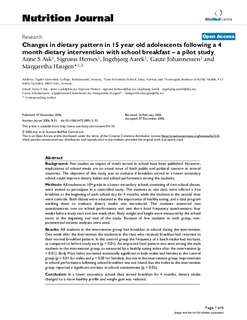| dc.contributor.author | Ask, Anne Selvik | |
| dc.contributor.author | Hernes, Sigrunn | |
| dc.contributor.author | Aarek, Ingebjørg | |
| dc.contributor.author | Johannessen, Gaute | |
| dc.contributor.author | Haugen, Margaretha | |
| dc.date.accessioned | 2008-12-03T09:54:39Z | |
| dc.date.issued | 2006-12-07 | |
| dc.identifier.citation | Ask, A. S., Hernes, S., Aarek, I., Johannessen, G. & Haugen, M. (2006). Changes in dietary pattern in 15 year old adolescents following a 4 month dietary intervention with school breakfast--a pilot study. Nutrition Journal, 5: 33. | en |
| dc.identifier.issn | 1475-2891 | |
| dc.identifier.uri | http://hdl.handle.net/11250/138975 | |
| dc.description | Originally published in Nutritional journal, BioMed Central, http://www.nutritionj.com/content/5/1/33 | |
| dc.description.abstract | BACKGROUND: Few studies on impact of meals served in school have been published. However, implications of school meals are an actual issue of both public and political concern in several countries. The objective of this study was to evaluate if breakfast served in a lower secondary school could improve dietary habits and school performance among the students. METHODS: All students in 10th grade in a lower secondary school, consisting of two school classes, were invited to participate in a controlled study. The students in one class were offered a free breakfast at the beginning of each school day for 4 months, while the students in the second class were controls. Both classes were educated in the importance of healthy eating, and a data program enabling them to evaluate dietary intake was introduced. The students answered two questionnaires, one on school performance and one short food frequency questionnaire, four weeks before study start and one week after. Body weight and height were measured by the school nurse at the beginning and end of the study. Because of few students in each group, non-parametrical statistic analyses were used. RESULTS: All students in the intervention group had breakfast at school during the intervention. One week after the intervention the students in the class who received breakfast had returned to their normal breakfast pattern. In the control group the frequency of a lunch intake had increase, as compared to before study start (p < 0.01). An improved food pattern was seen among the male students in the intervention group, as measured by a healthy eating index after the intervention (p < 0.01). Body Mass Index increased statistically significant in both males and females in the control group (p < 0,01 for males and p < 0.05 for females), but not in the intervention group. Improvement in school performance following school breakfast was not found, but the males in the intervention group reported a significant increase in school contentment (p < 0.05). CONCLUSION: In a lower secondary school class served breakfast for 4 months, dietary intake changed to a more healthy profile and weight gain was reduced | en |
| dc.format.extent | 229842 bytes | |
| dc.format.mimetype | application/pdf | |
| dc.language.iso | eng | en |
| dc.publisher | BioMed Central | en |
| dc.subject | Food Habits | en |
| dc.subject | Adolescent | en |
| dc.subject | Questionnaires | en |
| dc.subject | Food Services | en |
| dc.subject | Schools | en |
| dc.subject | Norway | en |
| dc.subject | Nutrition Policy | en |
| dc.title | Changes in dietary pattern in 15 year old adolescents following a 4 month dietary intervention with school breakfast – a pilot study | en |
| dc.type | Peer reviewed | en |
| dc.type | Journal article | en |
| dc.subject.nsi | VDP::Medical disciplines: 700::Health sciences: 800::Nutrition: 811 | en |
| dc.source.volume | 5 | en |
| dc.source.journal | Nutrition Journal | en |
| dc.source.issue | 33 | en |
